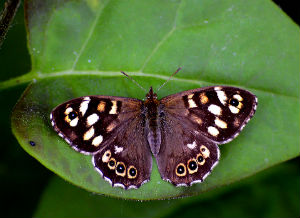First ever habitat connectivity report using species data shows positive impact of policies on butterflies
19 July 2018

Butterflies are benefitting from environmental action to increase their habitats, scientists have argued following a pioneering government report.
Research published today by Defra on the ability of butterflies to move around the countryside shows butterflies, including much-loved species like the Speckled Wood butterfly, have recovered significantly since a worrying decline at the end of the last millennium.
This connectivity data, provided for the first time by the University of Reading, Joint Nature Conservation Committee (JNCC), Centre for Ecology and Hydrology and Butterfly Conservation, is important as it could allow conservationists to better manage landscapes for biodiversity, if updated regularly. The University of Reading scientists contributed chapter C2 ‘Habitat Connectivity', which contains statistics on butterfly species connectivity over different time periods.
Lisbeth Morrison, biological scientist at the University of Reading, who led the connectivity analysis, said: "Until now, there has been no indicator giving a ‘species-eye view' of habitat connectivity for species in the UK, so this report is a huge step forward in understanding how they are coping with an ever-changing environment."
"The evidence suggests that policies put in place to protect habitats have been very effective for many butterflies. For example, woodland planting and restoration in the UK drastically increased during the 1980's, reaching peak levels of over 30,000 hectares planted in 1989. This now mature woodland has helped contribute towards increased numbers of butterflies, enabling species to be more connected across the landscape. Relatively simple changes to land management could have massive implications for biodiversity across the countryside and help prevent species that are enjoyed by millions from disappearing completely."
Tom Oliver, Professor of Applied Ecology at the University of Reading said: "The Speckled Wood butterfly is a species which is benefitting from woodland restoration with greater butterfly movement across the countryside, accompanied by an increase in population size in recent years."
University of Reading scientists analysed 33 butterfly species, using data from a long-term monitoring scheme, the UK Butterfly Monitoring Scheme between 1980 and 2016, to show the long-term trend in connectivity.
Thousands of volunteers are involved in collecting data on butterflies every week during the spring and summer at sites all across the UK. Butterfly numbers were monitored simultaneously at sites around the country to see if population increases in one area were mirrored elsewhere. This is an indicator of high connectivity.
The resulting data revealed that 62% of butterflies suffered a decline in their movements through the 1990s before a sharp increase after the turn of the millennium, resulting in the level of connectivity being 10% higher than any point in the last 36 years. This highlights the impact of habitat restoration and targeted landscape conservation efforts to help reduce the risk of butterflies from going extinct.
